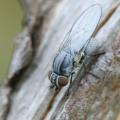Diptera.info :: Identification queries :: Diptera (adults)
Who is here? 1 guest(s)
|
Family ID problems.
|
|
| Nikita Vikhrev |
Posted on 03-06-2006 14:31
|
|
Member Location: Moscow, Russia Posts: 9399 Joined: 24.05.05 |
Central Turkey, 3 times (24-27may) I collected this fly on forewindow of my (rented) car. Altitiude 1100- 1700, 5,5-6mm. Looked like greenish Tephritidae with clean wings. But it seems to me that Sc do not reach C. Nikita Vikhrev attached the following image:  [68.1Kb] Nikita Vikhrev - Zool Museum of Moscow University |
|
|
|
| Kahis |
Posted on 04-06-2006 13:32
|
|
Member Location: Helsinki, Finland Posts: 1999 Joined: 02.09.04 |
Tephritidae indeed. Genus Terellia?
Kahis |
| Nikita Vikhrev |
Posted on 05-06-2006 13:02
|
|
Member Location: Moscow, Russia Posts: 9399 Joined: 24.05.05 |
Thank you Kahis.
Nikita Vikhrev - Zool Museum of Moscow University |
|
|
|
| Nikita Vikhrev |
Posted on 08-06-2006 17:57
|
|
Member Location: Moscow, Russia Posts: 9399 Joined: 24.05.05 |
I remove my Tephritidae in head, because it seems to me that mine and new Tephritidae by elck are of the same genus.
Nikita Vikhrev - Zool Museum of Moscow University |
|
|
|
| elck |
Posted on 08-06-2006 18:08
|
|
Member Location: Rotterdam, Netherlands Posts: 120 Joined: 21.03.05 |
Sorry, should I have chosen an other title?
Edited by elck on 08-06-2006 18:08 Regards, Elck (coccinellidae in dutch:http://stippen.nl) |
| Nikita Vikhrev |
Posted on 08-06-2006 20:16
|
|
Member Location: Moscow, Russia Posts: 9399 Joined: 24.05.05 |
If I'mn't mistaken, both our flies are, according Kahis, Terellia sp. So we have to wait John Smith appiarence to ID. Nikita Vikhrev - Zool Museum of Moscow University |
|
|
|
| John Smit |
Posted on 09-06-2006 16:52
|
|
Member Location: Utrecht Posts: 565 Joined: 05.10.04 |
Eheh! And you're expecting and ID from me..... It is Terrellia alright, the serratulae-species complex. Three species in western Europe, I'm not entirely sure if there are more in this complex in Turkey. It's not T. fuscicornis, for that one has the third antennal segment black. But it can be either T. serratulae or T. longicauda, males are practicaly inseperable, females however are separable. For the males you need to look at the genitalia, hte hairs on the surstyli are mostly longer in T. longicauda and shorter in T. serratulae, but you need reference material and it is not always clear, so you'll need a series of males. So for the next time: collect females!  John Edited by John Smit on 09-06-2006 16:53 |
| Nikita Vikhrev |
Posted on 09-06-2006 17:46
|
|
Member Location: Moscow, Russia Posts: 9399 Joined: 24.05.05 |
One family - collect male, another - collect female. Once someboby will tell me - collect larva! Thank you John. One out of two species - not bad. And I'll check, may be I have female collected. Nikita Vikhrev - Zool Museum of Moscow University |
|
|
|
| John Smit |
Posted on 11-06-2006 13:31
|
|
Member Location: Utrecht Posts: 565 Joined: 05.10.04 |
Hi Nikita, It's not even so among different families, but even within one family! To be on the safe side, just collect series...  John |
| Jump to Forum: |















